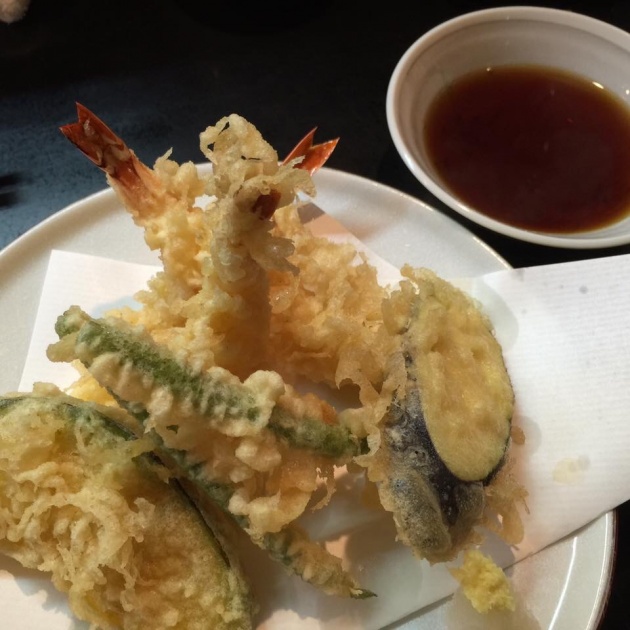One of my favorite dish here in Japan is Tempura , I will share you the ingredients .
Ingredients:
4-8 medium shrimp
6-inch (15cm) piece raw squid
4-8 small sillago (kisu) fillets, or fillets of small white-fleshed fish
2-3 medium onions
4-5 inches (10-13cm) lotus root
4-8 shiitake mushrooms or white mushrooms, wiped and trimmed
1-2 sweet potatoes
4-8 shiso leaves
15-16 stalks trefoil
dipping sauce:
1 cup dashi
1/3 cup mirin
1/3 cup light soy sauce
1 cup grated giant white radish (daikon oroshi)
few tsps finely grated fresh ginger
batter:
2 egg yolks
2 cups ice water
2 cups sifted flour
oil for deep frying
* This is for 4 servings *
Directions
To prepare:
Shell and devein shrimp, but leave tails attached. Chop off the tips of shrimp tails and gently press out moisture from shrimp with the flat of the knife tip. To prevent shrimp from curling as they are deep-fried, make a few deep incisions along the belly, as shown, and then lightly tap across each shrimp with back of knife blade.
Cut squid into 1 1/2-inch (4cm) squares, then cross-score the outer, smooth side of each piece lightly.
Use the sanmai oroshi technique (pp 123-) for sillago or other small fish, but in this case stop the knife at the base of the tail and cut off and remove the central bone as close to the tail as possible. The result is 2 fillets attached to a tail. This may be tricky, and is mainly decorative anyway; it is no disaster if the fillets have no tails. Clean and pat dry sillago fillets. If you are using fillets of a large white-fleshed fish, remove bones and cut fillets crosswise into bite-sized pieces.
Pierce onions with toothpicks then cut into rounds, as shown, to keep rounds from falling apart into rings.
Scrape lotus root and slice into rounds. Place immediately in weak vinegar-water to prevent discoloration.
If mushroom caps are very large, cut in half.
Peel sweet potato and slice crosswise into rounds.
Wash and pat dry shiso leaves.
Hold 3 or 4 trefoil stalks together and tie into a knot just below leaves. Trim off stalks about 1 1/2 inches (4cm) below knot.
Prepare the dipping sauce by combining ingredients over heat and bringing just to a boil. Keep warm.
Grate radish and ginger.
To deep-fry:
Make the batter in 2 batches, the first batch just before you are ready to begin deep-frying, as you are waiting for the oil to heat. In a mixing bowl, lightly beat 1 egg yolk, then pour in 1 cup of ice water and give this a few strokes. Add 1 cup sifted flour all at once. Stroke a few times with chopsticks or fork, just till ingredients are loosely combined. The batter should be very lumpy. If you overmix, the batter will be sticky and the coating will turn out oily and heavy. Mix the batter with the least amount of movement. Make the second batch of batter as the first is used up.
The oil should be fairly hot, about 340° F/170° C. Test by dropping a tiny bit of batter into the oil; it should descend slightly beneath the surface of the oil, then be buoyed up to the surface, the oil gently bubbling round its edges.
When you begin to deep-fry, set up the area around the heating unit like an assembly line: a tray or several trays of foods to be fried, a container of flour for dipping, and the batter bowl at your left; the hot oil pot at center; the rack for draining and skimmers and chopsticks and slotted spoons, at right. Try to arrange the physical layout and your timing to serve the tempura immediately after frying, but if you cannot, keep foods hot.
Each food item progresses through the assembly line in this way; use fingers to dip food in flour, shake off excess, then dip in batter; lay or slide coated material in hot oil and deep-fry till golden, around 3 minutes, turning in the oil for even cooking. Retrieve with slotted spoon or cooking chopsticks and briefly drain before transferring to serving plate. Skim the surface of the oil occasionally to keep it clean. Stir batter once or twice as you work, to keep it from separating.
Begin with vegetables, then move on to shrimp and fish or other foods that need a higher oil temperature.
There are exceptions to this flour- and batter-coating process - shiso leaves, nori seaweed and knotted trefoil are not dipped in flour and are batter-coated on the "back" side only. If these are completely covered with batter, their color or texture would be lost.
To serve:
A bar-type arrangement that allows you to serve diners directly from the stove or from a deep-fryer at a sideboard is ideal for tempura. Diners should be provided with a plate or bamboo tray lined with absorbent paper on which tempura is placed as it is done. If, on the other hand, you have to bring the deep-fried food from kitchen to table, arrange 8 or 10 pieces of tempura (2 shrimp, 2 fish, and several vegetables) on paper-lined places or trays and serve that way.
At the table, pour hot dipping sauce into a small bowl, mix in grated daikon and a bit of grated ginger, if desired. Dip tempura in this sauce and eat.




